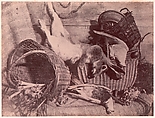Nature morte au lièvre
Unknown
Printer Imprimerie photographique de Blanquart-Évrard, à Lille French
Not on view
After learning the British inventor William Henry Fox Talbot’s calotype process, Louis-Désiré Blanquart-Évrard introduced to France the method of producing and printing from paper negatives. Determined to print photographs on an industrial scale, he opened the first photographic press in France in 1851. He initially made albums of various subjects that he hoped would appeal to artists and publishers who might then use paper photographs to illustrate books. This still life, issued in the album Études photographiques, was one of more than 550 such images by various photographers that Blanquart-Évrard printed over five years. Despite this output, the photographs were significantly more expensive than competing lithographs, and the factory closed in 1855.
Due to rights restrictions, this image cannot be enlarged, viewed at full screen, or downloaded.

